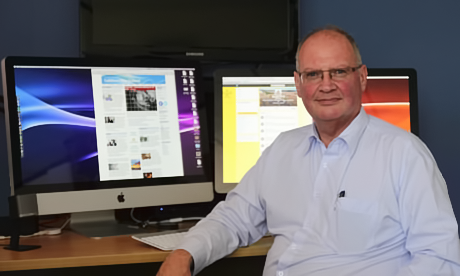As a somewhat old-fashioned, traditional type, I welcomed the engaging presence and comment of Dame Lyndsay Freer to my radio and TV during the recent papal conclave.
Long before the advent of television, St Thomas Aquinas said, “faith comes from hearing“, and the Catholic Church in New Zealand, once again, at least for a limited time, had a face and a voice.
Around about five years ago the Catholic Church in New Zealand opted for a new model of communications, and rather than the face and voice of one spokesperson, it looked to spread the load and bring more spokespeople to the fore.
At the time, spreading the load, new faces, new voices, different faces, different voices, different ways of seeing the Church through the media, sounded like quite a good plan.
It probably still is, but I’m beginning to wonder if it is too adventurous a plan for a small country, because in the five years or so since Catholic Communications closed the Church seems to have become faceless and voiceless.
Yes, there have been numerous media releases, Tweets and Facebook posts. There’s even been an occasional media comment by a bishop or Church spokesperson, but they seem to have mainly fallen on deaf ears.
Media relations is a special skill
I think it’s generally true that most organisations prefer the media to tell ‘their’ version of the truth. The Church, which prides itself on truth, is no exception.
Church truth, its belief and practice, is often somewhat nuanced as evidenced by Anthony Faiola of the Washington Post who reported recently on Pope Benedict’s last public mass.
Describing Benedict’s movements, Failoa wrote in the Washington Post: “He walked with a gilded cane in the shape of a cross” as people cheered “Long live the Pope!”
The “gilded cane in the shape of a cross” was actually a crozier, the shepherd’s staff that symbolizes a bishop’s role as the leader of his flock.
Sometimes it seems the media just doesn’t ‘get’ the nuance of the Church.
The Church may not have a monopoly on the media not understanding its stories and events, but living in a post-Christian focussed society, it’s kind of understandable the media doesn’t have religious experts, understanding for example, Church theology, philosophy, history and liturgy.
The former Cardinal, Jorge Bergoglio, was often described as a shy man with an aversion to journalists, but on the day of his inauguration as Pope, Francis acknowledged the work of the media representatives, greeting them as “My dear friends”.
His comments were greeted with cheers and several reporters shouted “Viva!”.
Pope Francis clearly understands the importance of a relationship with the media, but it is likely to be rare that he meets with them.
As well as using media statements and social media to engage with society, the media also want a face, a person to relate to and with whom they can build a relationship and trust.
Pope Francis will generally use a Vatican spokesman to tell the Church’s story and to keep the relationship alive.
For many years the Catholic Church in New Zealand fostered relationships with the New Zealand media. However by remodelling its communications, it seems to me we may have lost some impetus, lost our edge, lost our important perspective in a post-modern society.
For example I find it interesting that the New Zealand media is now preferring former TV reporter and now Anglican priest and communications spokesman Jayson Rhodes or a myriad of faceless university academics to talk about the church and matters of interest to the church and society.
It’s perhaps timely to again recall Thomas Aquinas’, “faith comes from hearing“, and ask whose faith, and what is it that people are hearing?
I guess it’s now no secret that I’m applauding the personal initiative of Auckland Bishop, Patrick Dunn, to send Lyndsay Freer to Rome to cover the Papal conclave and election of Pope Francis.
My reading of the situation is it seemed that after Dame Lyndsay arrived in Rome the New Zealand media seemed better informed, that she seemed to ease their way though something generally quite foreign to them, and the people of New Zealand and the Church both benefitted from her skill.
In today’s world, the Church is regarded as somewhat counter-cultural, and as such the cultural void brings with it a great opportunity.
There is something unique about how the Church relates to the media as distinct from that of PR spokespeople from politics and the public sector generally.
Church media spokespeople are distinct from ‘public relations’ spokespeople in politics and business. As a result, there are a number of factors the media and New Zealanders expect from Church media spokespeople, that I think makes this specialist role worthy of further re-consideration:
- to be immediately available
- to be well educated with respect to catholic theology, history, liturgy and practice
- to be informed and if necessary to be able to arrange to get the right person to speak at short notice
- to be able to speak to New Zealand society in a way appropriate to the medium
- to have a warm and personal manner
- to have a sense of humour
- to be relaxed under pressure
- to engage in conversational style
- to be able to think on their feet while fronting the nation’s media
- to be across development in new media and apply them appropriately to the Church’s message
- and ultimately, to be credible.
When I look back at this list of skills and abilities that a professional Church media spokesperson needs, and match them against the opportunities to effectively outreach into to the wider New Zealand society through the media, I can only conclude this is indeed a specialist task requiring a full time media office for the Catholic Church in New Zealand.
– John Murphy is a Marist priest working in digital media at the Marist Internet Ministry, New Zealand.
Additional readingNews category: Analysis and Comment.




